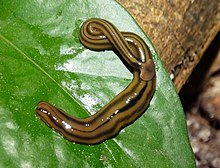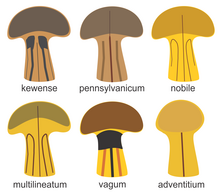ബൈപാലിയം
| ബൈപാലിയം | |
|---|---|

| |
| Bipalium kewense | |
| ശാസ്ത്രീയ വർഗ്ഗീകരണം | |
| കിങ്ഡം: | |
| Phylum: | Platyhelminthes
|
| Class: | Rhabditophora
|
| Order: | Tricladida
|
| Suborder: | Continenticola
|
| Family: | Geoplanidae
|
| Subfamily: | |
| Genus: | Bipalium Stimpson, 1857[1]
|
| Type species | |
| Bipalium fuscatum Stimpson, 1857
| |
| Synonyms | |
| |
ഇരപിടിയൻമാരായ ലാൻഡ് പ്ലാനേറിയൻ ജനുസ്സാണ് ബൈപാലിയം. തലയുടെ സവിശേഷമായ ആകൃതി കാരണം അവയെ പലപ്പോഴും ഹാമർഹെഡ് വിരകൾ, ബ്രോഡ്ഹെഡ് പ്ലാനേറിയൻ എന്നെല്ലാം വിളിക്കുന്നു. ഈയിനത്തിൽപ്പെട്ട സ്പീഷീസുകളെയെല്ലാം മലയാളത്തിൽ അറിയപ്പെടുന്നത് താപ്പാമ്പ് എന്നാണ്. ഭൂമിയുടെ വിവിധഭാഗങ്ങളിലെ ഇനങ്ങൾ മറ്റുഭാഗങ്ങളിലേക്ക് അധിനിവേശം നടത്തുന്നതായി പഠനങ്ങൾ വ്യക്തമാക്കുന്നു. [2][3][4][5]
വിവരണം
[തിരുത്തുക]വില്യം സ്റ്റിംപ്സൺ ആണ് ബൈപാലിയം ജനുസ്സിനെ ആദ്യമായി നിർവചിച്ചത്. പിന്നീട് 1899-ൽ ലുഡ്വിഗ് വോൺ ഗ്രാഫ് അതിന്റെ തലയുടെ ആകൃതി അനുസരിച്ച് മൂന്ന് വിഭാഗങ്ങളായി തരംതിരിച്ചു:[6]
- ബൈപാലിയം : നന്നായി വികസിച്ച ഹെഡ് പ്ലേറ്റ്, വളരെ വീതിയുള്ള ഘടന, നീളമേറിയ ലാറ്ററൽ ഓറിക്കിൾസ്
- പെറോസെഫാലസ് : അടിസ്ഥാന ഹെഡ് പ്ലേറ്റ്, ശരീരത്തിന്റെ വീതി കുറവ്.
- പ്ലാക്കോസെഫാലസ് : വൃത്താകൃതിയിലുള്ള പരന്ന ഹെഡ് പ്ലേറ്റ്, വൃത്താകൃതമായ ഘടന
ആന്തരികഘടനാപരമായ വ്യത്യാസമൊന്നുമില്ലാത്തതിനാൽ, ഈ വർഗ്ഗീകരണത്തിൽ വസ്തുതയില്ലെന്ന്, 1902 ൽ ജോസഫ് മുള്ളർ നിരീക്ഷിക്കുകയും ബൈപാലിയം എന്ന ഒറ്റ വിഭാഗത്തിലേക്ക് ഉൾപ്പെടുത്തുകയും ചെയ്തു.
20-ാം നൂറ്റാണ്ടിന്റെ അന്ത്യത്തോടെ, റോബർട്ട് ഇ ഒഗ്രെൻ, മസഹരു കവകത്സു എന്നിവർ പ്രത്യുത്പാദന അവയവങ്ങളുടെ അനാട്ടമി അടിസ്ഥാനത്തിൽ ഇവയെ ബൈപാലിയം, നൊവിബൈപാലിയം, ഹംബെർഷിയം, ഡൈവേർഷിബൈപാലിയം എന്നിങ്ങലെ നാലു വിഭാഗങ്ങളായി തിരിച്ചു.
ഈ സാഹചര്യത്തിൽ, ബിപാലിയം ജനുസ്സിൽ നിർവചിച്ചിരിക്കുന്നത് വിശാലമായ തലയുള്ള ലാൻഡ് പ്ലാനേറിയൻ ഇനത്തെയാണ്. ലളിതമായ പ്രത്യുൽപാദന അവയവങ്ങളുള്ള ഇവയ്ക്ക്, ആക്സസറി ഡക്ടുകളോ കോപ്പുലേറ്ററി ബർസയോ ഇല്ല. പുരുഷ-സ്ത്രീ എക്സിറ്റ് ഡക്ടുകളെ വേർതിരിക്കുന്നതിനുള്ള ഒരു പാളി മാത്രമേ കാണപ്പെടുന്നു.
പദോൽപ്പത്തി
[തിരുത്തുക]ബൈ- പാല എന്നീ ലാറ്റിൻ പദങ്ങളിൽ നിന്നാണ് ബൈപാലിയം എന്ന പദോൽപത്തി. കോരിക അല്ലെങ്കിൽ പിക്കാക്സ് എന്നിവയിൽ നിന്നാണ് ഈ പേര് വന്നത്. ഈ ജനുസ്സിലെ ഇനങ്ങൾ പിക്കാക്സിനോട് സാമ്യമുള്ളതാണ്. [7]
സ്പീഷീസ്
[തിരുത്തുക]ബിപാലിയം ജനുസ്സിൽ നിലവിൽ ഇനിപ്പറയുന്ന ഇനം ഉൾപ്പെടുന്നു:
- Bipalium adensameri Graff, 1899
- Bipalium admarginatum de Beauchamp, 1933
- Bipalium adventitium Hyman, 1943
- Bipalium alternans de Beauchamp, 1930
- Bipalium bergendali (Graff, 1899)
- Bipalium cantori (Wright, 1860)
- Bipalium choristosperma de Beauchamp, 1925
- Bipalium crassatrium de Beauchamp, 1939
- Bipalium distinguendum Müller, 1907
- Bipalium dubium Loman, 1890
- Bipalium ephippium Loman, 1890
- Bipalium fuscatum Stimpson, 1857
- Bipalium fuscolineatum Kaburaki, 1922
- Bipalium gestroi Graff, 1894
- Bipalium glandiantrum Kawakatsu, Sluys & Ogren, 2005
- Bipalium glaucum (Kaburaki, 1922)
- Bipalium gracile Loman, 1890
- Bipalium graffi Müller, 1903
- Bipalium haberlandti Graff, 1899
- Bipalium hilgendorfi (Graff, 1899)
- Bipalium interruptum Graff, 1899
- Bipalium javanum Loman, 1883
- Bipalium kaburakii Kawakatsu, Sluys & Ogren, 2005
- Bipalium katoi Kawakatsu, Sluys & Ogren, 2005
- Bipalium kewense Moseley, 1878
- Bipalium kisoense Kaburaki, 1922
- Bipalium koreense Frieb, 1923
- Bipalium kraepelini (Ritter-Záhony, 1905)
- Bipalium marginatum Loman, 1887
- Bipalium mjobergi de Beauchamp, 1925
- Bipalium monolineatum Kaburaki, 1922
- Bipalium moseleyi Loman, 1887
- Bipalium muninense Kawakatsu, Sluys & Ogren, 2005
- Bipalium myadenosum de Beauchamp, 1939
- Bipalium nigrum (Ritter-Záhony, 1905)
- Bipalium nobile Kawakatsu & Makino, 1982
- Bipalium ochroleucum Kaburaki, 1922
- Bipalium pennsylvanicum Ogren, 1987
- Bipalium penrissenicum Kawakatsu, Ogren & Froehlich, 1998
- Bipalium penzigi Müller, 1903
- Bipalium persephone de Beauchamp, 1939
- Bipalium poiense de Beauchamp, 1925
- Bipalium rigaudi Graff, 1894
- Bipalium robiginosum Graff, 1899
- Bipalium semperi (Graff, 1899)
- Bipalium simrothi Loman, 1895
- Bipalium strubelli Graff, 1899
- Bipalium sudzuki Kawakatsu, 1986
- Bipalium tetsuyai Kawakatsu, Sluys & Ogren, 2005
- Bipalium univittatum Grube, 1866
- Bipalium vagum Jones & Sterrer, 2005
- Bipalium virile Müller, 1903
- Bipalium weismanni Ritter-Záhony, 1905
- Bipalium wiesneri Graff, 1899
ഭക്ഷണ ശീലം
[തിരുത്തുക]ബൈപാലിയം ഇരപിടിയൻമാരാണ്. ചിലവ മണ്ണിരകളെ ഇരയാക്കുന്നു, മറ്റു ചിലത് മോളസ്കുകളെ ഭക്ഷണമാക്കുന്നു. [8] [9] ഈ പരന്ന വിരകൾക്ക് ഇരയെ കണ്ടെത്താൻ കഴിയും.[10] പിടികൂടുമ്പോൾ, മണ്ണിരകൾ ആക്രമണത്തോട് പ്രതികരിക്കാൻ തുടങ്ങുന്നു, പക്ഷേ ഒരു ബൈപാലിയം അതിന്റെ ശരീരത്തിലെ പേശികളെയും സ്റ്റിക്കി സ്രവങ്ങളെയും ഉപയോഗിച്ച് ഇരയെ നിയന്ത്രണത്തിലാക്കുന്നു. മണ്ണിരയുടെ അക്രമാസക്തമായ പ്രതികരണം തടയാൻ പ്ലാനേറിയ മണ്ണിരയുടെ പ്രോസ്റ്റോമിയം, പെരിസ്റ്റോമിയം എന്നിവ മൂടുന്നു. [11]
ബൈപാലിയത്തിന്റെ ശരീരത്തിന്റെ മധ്യഭാഗത്താണ് വായ. ഇത് തുറന്ന്, അണ്ണാക്ക് പുറത്തേക്കിട്ട് ഇരയുടെമേൽ എൻസൈമുകൾ സ്രവിക്കുന്നു. മണ്ണിരയുടെ ശരീരം അതുപയോഗിച്ച് ദഹിപ്പിക്കുന്നു. ദഹിച്ച, ദ്രവീകൃതമായ സത്ത് വായവിടവിലൂടെ സിലിയ ചലനം വഴി ആഗിരണം ചെയ്യുന്നു. [12]
പുനരുൽപാദനം
[തിരുത്തുക]ബൈപാലിയത്തിലെ പുനരുൽപാദനം അലൈംഗികമോ ലൈംഗികമോ ആകാം, എല്ലാ ജീവജാലങ്ങളും ഹെർമാഫ്രോഡിറ്റിക് ആണ്.[5][13]
വിഷാംശം
[തിരുത്തുക]ബൈപാലിയത്തിന്റെ ചില ഇനങ്ങളിൽ വിഷസാന്നിധ്യം കണ്ടെത്തിയിട്ടുണ്ട്. ഭൂമിയിലെ അകശേരുക്കളിൽ ടെട്രോഡോടോക്സിന്റെ ആദ്യത്തെ രേഖപ്പെടുത്തലാണിത്.[14]
ആക്രമണാത്മക ഇനം
[തിരുത്തുക]
ടെറസ്ട്രിയൽ പ്ലാനേറിയയുടെ പരിസ്ഥിതിയെക്കുറിച്ച് വളരെക്കുറച്ചേ അറിവുള്ളൂ, പക്ഷേ ബ്രസീലിലെ നിരവധി നേറ്റീവ്, അധിനിവേശ ജീവികൾ, [15] ആർതർഡെൻഡിയസ് ട്രയാംഗുലറ്റസ്, [16] റൈൻകോഡെമസ് [17], ബൈപാലിയം എന്നിവയുൾപ്പെടെ വിവിധ ഇനങ്ങളെയും ജീവജാലങ്ങളെയും കുറിച്ച് ഗവേഷണം നടന്നിട്ടുണ്ട്. [18]
ഹരിതഗൃഹങ്ങളിൽ ബൈപാലിയം കെവൻസ് സാധാരണയായി കാണപ്പെടുന്നു. [19] മണ്ണിരകളെ വേട്ടയാടുന്ന ഈ ഇനം മണ്ണിര വളർത്തലിന് ഒരു ശല്യമായി തിരിച്ചറിഞ്ഞിട്ടുണ്ട്. [20]
മറ്റ് ജീവികൾ അപൂർവ്വമായി മാത്രമേ ലാൻഡ് പ്ലാനേറിയൻമാരെ വിഴുങ്ങുന്നുള്ളൂ. ശരീര ഉപരിതല സ്രവങ്ങൾ അപകടകരമായ അളവിൽ വിഷമയമല്ലെങ്കിലും അരുചിയുണ്ടാക്കുന്നതാണ് ഇതിന് കാരണം. ഫ്ലാഗെല്ലേറ്റുകൾ, സിലിയേറ്റുകൾ, സ്പോറോസോവൻ, നെമറ്റോഡുകൾ എന്നിവയുൾപ്പെടെയുള്ള പ്രോട്ടോസോവനുകളെ ലാൻഡ് പ്ലാനേറിയൻമാരിൽ കണ്ടെത്തിയിട്ടുണ്ട്. ലാൻഡ് പ്ലാനേറിയൻമാർ അവയുടെ ഇനത്തിൽപ്പെട്ടവയെത്തന്നെ ആഹരിക്കാറുണ്ട്. [21]
ചിത്രശാല
[തിരുത്തുക]
അവലംബം
[തിരുത്തുക]
- ↑ Stimpson (1857). "Prodromus descriptionis animalium evertebratorum quæ in Expeditione ad Oceanum, Pacificum Septentrionalem a Republica Federata missa, Johanne Rodgers Duce, observavit er descripsit. Pars I. Turbellaria Dendrocœla". Proc. Acad. Nat. Sci. Phila. 1857: 25.
- ↑ Ogren, R.E. 1985. The human factor in the spread of an exotic land planarian in Pennsylvania. Proc. of the Penn. Acad. of Sci. 59: 117-118.
- ↑ Justine, Jean-Lou; Winsor, Leigh; Gey, Delphine; Gros, Pierre; Thévenot, Jessica (2018). "Giant worms chez moi! Hammerhead flatworms (Platyhelminthes, Geoplanidae, Bipalium spp., Diversibipalium spp.) in metropolitan France and overseas French territories". PeerJ. 6: e4672. doi:10.7717/peerj.4672. ISSN 2167-8359. PMC 5969052. PMID 29844951.
((cite journal)): CS1 maint: unflagged free DOI (link)
- ↑ Filella-Subira, E (1983). ""Nota sobre la presència de la planària terrestre Bipalium kewense Moseley, 1878 a Catalunya"". Butll. Inst. Cat. Hist. Nat. 49: 151.
- ↑ 5.0 5.1 Ducey, P. K.; West, L. J.; Shaw, G.; De Lisle, J. (2005). "Reproductive ecology and evolution in the invasive terrestrial planarian Bipalium adventitium across North America". Pedobiologia. 49 (4): 367. doi:10.1016/j.pedobi.2005.04.002.
- ↑ Ogren, R. E.; Kawakatsu, M. (1987). "Index to the species of the genus Bipalium (Turbellaria, Tricladida, Terricola)". The Bulletin of Fuji Women's College Series 2. 25 (2): 79–119.

- ↑ Stimpson, W. (1861). "On the genus Bipaliura". American Journal of Science and Arts. Series 2. 31: 134–135.
- ↑ Ogren, R. E. (1995). "Predation behaviour of land planarians". Hydrobiologia. 305 (1–3): 105–111. doi:10.1007/BF00036370.
- ↑ Ducey, P. K., M. McCormick, and E. Davidson. 2007. Natural history observations on Bipalium cf. vagum Jones and Sterrer, 2005 (Platyhelminthes: Tricladida), a terrestrial broadhead planarian new to North America. Southeastern Naturalist.
- ↑ Fiore, C.; Tull, J. L.; Zehner, S.; Ducey, P. K. (2004). "Tracking and predation on earthworms by the invasive terrestrial planarian Bipalium adventitium (Tricladida, Platyhelminthes)". Behavioural Processes. 67 (3): 327–334. doi:10.1016/j.beproc.2004.06.001. PMID 15518983.
- ↑ Ducey, P. K.; Messere, M.; Lapoint, K.; Noce, S. (1999). "Lumbricid Prey and Potential Herpetofaunal Predators of the Invading Terrestrial Flatworm Bipalium adventitium (Turbellaria: Tricladida: Terricola)". The American Midland Naturalist. 141 (2): 305. doi:10.1674/0003-0031(1999)141[0305:LPAPHP]2.0.CO;2.
- ↑ Dindal, D.L. (1970). "Feeding behavior of a terrestrial turbellarian Bipalium adventitium". The American Midland Naturalist. 83 (2): 635–637. doi:10.2307/2423970. JSTOR 2423970.
- ↑ Winsor, L. (1983). "A revision of the cosmopolitan land planarian Bipalium kewense Moseley, 1878 (Turbellaria: Tricladida: Terricola)". Zoological Journal of the Linnean Society. 79 (1): 61–100. doi:10.1111/j.1096-3642.1983.tb01161.x. ISSN 0024-4082.
- ↑ Stokes, A. N.; Ducey, P. K.; Neuman-Lee, L.; Hanifin, C. T.; French, S. S.; Pfrender, M. E.; Brodie, E. D.; Brodie Jr., E. D. (2014). "Confirmation and Distribution of Tetrodotoxin for the First Time in Terrestrial Invertebrates: Two Terrestrial Flatworm Species (Bipalium adventitium and Bipalium kewense)". PLoS ONE. 9 (6): e100718. Bibcode:2014PLoSO...9j0718S. doi:10.1371/journal.pone.0100718. PMC 4070999. PMID 24963791.
((cite journal)): CS1 maint: unflagged free DOI (link)- ↑ Leal-Zanchet, A. M.; Baptista, V.; Campos, L. M.; Raffo, J. F. (2011). "Spatial and temporal patterns of land flatworm assemblages in Brazilian Araucaria forests". Invertebrate Biology. 130: 25–33. doi:10.1111/j.1744-7410.2010.00215.x.
- ↑ Jones, H. D. and B. Boag. 2001. The invasion of New Zealand flatworms. Glasgow Naturalist 23(supplement):77-83.
- ↑ Ogren, R.E. (1955). "Ecological observations on the occurrence of Rhynchodemus, a terrestrial turbellarian". Transactions of the American Microscopical Society. 74 (1): 54–60. doi:10.2307/3223842. JSTOR 3223842.
- ↑ Ducey, P. K.; Noce, S. (1998). "Successful invasion of New York State by the terrestrial flatworm, Bipalium adventitium". Northeastern Naturalist. 5 (3): 199–206. doi:10.2307/3858619. JSTOR 3858619.
- ↑ Esser, R. P. 1981. Land Planarians (Tricladida: Terricola). Contribution no. 227, Bureau of Nematology, Florida Department of Agricultural and Consumer Services, Division of Plant Industry, Gainesville, Fl.
- ↑ Hyman, L. H. 1951. The Invertebrates: Platyhelminthes and Rhynchocoela the acoelomate Bilateria, McGraw-Hill Book Co., London, 550 p.
- ↑ Choate, P.M., and Dunn, R.A., 1988. Land Planarians, Bipalium kewense Moseley and Dolichoplana striata Moseley (Tricladida: Terricola), IFAS Document EENY-049. Online:Available http://edis.ifas.ufl.edu/pdffiles/IN/IN20600.pdf
Text is available under the CC BY-SA 4.0 license; additional terms may apply.
Images, videos and audio are available under their respective licenses.








